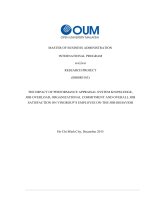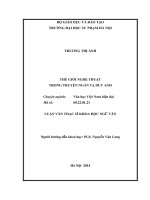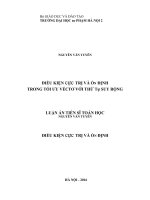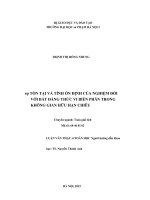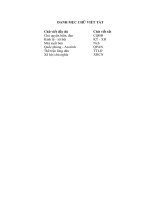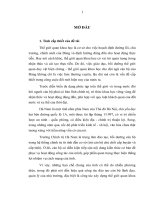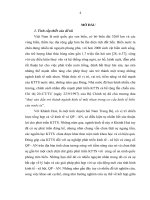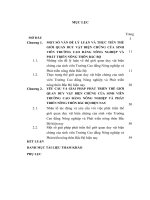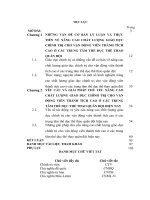(Luận văn thạc sĩ) the impact of managerial coaching on employee job satisfaction, organizational commitment and turnover intention in transportation and logistics companies in vietnam
Bạn đang xem bản rút gọn của tài liệu. Xem và tải ngay bản đầy đủ của tài liệu tại đây (853.78 KB, 68 trang )
VIETNAM NATIONAL UNIVERSITY, HANOI
VIETNAM JAPAN UNIVERSITY
VU THI THUY TIEN
THE IMPACT OF MANAGERIAL
COACHING ON EMPLOYEE JOB
SATISFACTION, ORGANIZATIONAL
COMMITMENT, AND TURNOVER
INTENTION IN TRANSPORTATION AND
LOGISTICS COMPANIES IN VIETNAM
MASTER’S THESIS
BUSINESS ADMINISTRATION
Hanoi, 2019
VIETNAM NATIONAL UNIVERSITY, HANOI
VIETNAM JAPAN UNIVERSITY
VU THI THUY TIEN
THE IMPACT OF MANAGERIAL
COACHING ON EMPLOYEE JOB
SATISFACTION, ORGANIZATIONAL
COMMITMENT, AND TURNOVER
INTENTION IN TRANSPORTATION AND
LOGISTICS COMPANIES IN VIETNAM
MAJOR: MASTER OF BUSINESS ADMINISTRATION
CODE: 60340102
RESEARCH SUPERVISORS:
PROF. DR. DANIEL ARTURO HELLER
DR. DO XUAN TRUONG
Hanoi, 2019
ACKNKOWLEDGEMENT
This thesis research would have never been completed without the help of numerous
people and institutions.
First of all, I would like to send my greatest gratitude to two of my direct advisors in
Japan and Vietnam, Prof. Dr. Daniel Arturo Heller and Dr. Do Xuan Truong, who have
given me a lot of super helpful advices during my execution of this graduation master
thesis.
I also would like to sincerely thank to the support of other Professors from the Business
Administration Faculty of Vietnam Japan University and Yokohama National
University who did teach me so many things of doing an academic research. In
addition, I know for sure that I myself could not have finished my thesis without the
reference materials provided by the libraries of Yokohama National University,
Vietnam Japan University and Vietnam National University.
My great thank you would also like to send to my family, my parents, my elder sister
and all of my best friends who have been encouraging me to stay strong whenever I
became so stressful.
Last but not least, I would like to say thank you to all of the participants joining into
my research. They play an extremely important role in my study and I know that
without their helps, my study could not go to the end.
1
TABLE OF CONTENTS
CHAPTER 1 : INTRODUCTION ................................................................................... 8
1.1. Problem statement .............................................................................................. 9
1.2. Purpose of the study ......................................................................................... 11
1.3. Significance of the study .................................................................................. 11
1.4. Content of the study.......................................................................................... 12
CHAPTER 2 : REVIEW OF LITERATURE ................................................................ 13
2.1. Managerial Coaching ........................................................................................ 13
2.1.1.
History of Coaching ............................................................................... 13
2.1.2.
Definitions of Coaching and Managerial Coaching .............................. 13
2.1.3.
The competencies of managerial coaching ............................................ 16
2.1.4.
Managerial Coaching in Collectivistic Cultures ................................... 18
2.2. Employee Job Satisfaction................................................................................ 19
2.3. Employee Organizational Commitment ........................................................... 20
2.4. Turnover Intention ............................................................................................ 21
2.5. Organization Support Theory ........................................................................... 21
2.6. Research Model and Hypotheses ...................................................................... 22
2.6.1.
Managerial Coaching and Employee Job Satisfaction .......................... 23
2.6.2.
Managerial Coaching and Employee Organizational Commitment ...... 23
2.6.3.
Managerial Coaching and Employee Turnover Intention ..................... 24
In the empirical study in technology companies, Park (2007) did found one of the
results of managerial coaching was to reduce employee turnover intention. In
combination with Organization Support theory, the third hypothesis is built as
below: 24
2.6.4.
Employee Job Satisfaction, Employee Organizational Commitment and
Employee Turnover Intention. ................................................................................ 25
2
CHAPTER 3 : METHODOLOGY ................................................................................ 26
3.1. Participants and Data Collection Procedures ................................................... 26
3.2. Measures ........................................................................................................... 26
3.3. Data analysis Methods ...................................................................................... 27
CHAPTER 4 : RESULTS AND FINDINGS ................................................................. 29
4.1. Demographic information of respondents ........................................................ 29
4.2. Descriptive Statistics ........................................................................................ 30
4.3. Reliability tests ................................................................................................. 32
4.3.1.
Measured instruments of managerial coaching ..................................... 32
4.3.2.
Measured instruments of employee job satisfaction .............................. 33
4.3.3.
Measured instruments of Organizational Commitment ......................... 34
4.3.4.
Measured instruments of employee turnover intention .......................... 36
4.4. Exploratory Factor Analysis (EFA) .................................................................. 38
Firstly, to confirm if AC2 and TI5 should be removed from the measured
instruments or not, the EFA with initial 24 factors was performed with the results as
following: ................................................................................................................... 38
4.5. Correlation Matrix ............................................................................................ 44
4.6. Regression ........................................................................................................ 45
4.6.1.
Testing hypothesis 1: Managerial coaching significantly positively
impacts on Job Satisfaction .................................................................................... 45
4.6.2.
Testing hypothesis 2: Managerial coaching significantly positively
impacts on Employee Organizational Commitment .............................................. 46
4.6.3.
Testing hypothesis 3: Managerial coaching negatively impacts on
Employee Turnover Intention ................................................................................. 47
4.6.4.
Testing hypothesis 4: Employee Job Satisfaction significantly positively
impacts on Employee Organizational Commitment .............................................. 49
4.6.5.
Testing hypothesis 5: Employee Job Satisfaction significantly negatively
impacts on Employee Turnover Intention .............................................................. 50
3
CHAPTER 5 : DICUSSION .......................................................................................... 52
5.1. Summary of the study‟s results ........................................................................... 52
5.2. Discussion and Implications ............................................................................... 53
5.3. Limitation and Direction for future studies......................................................... 54
REFERENCES ............................................................................................................... 56
APPENDIX: SURVEY QUESTIONNAIRE................................................................. 63
4
LIST OF TABLES
Table 2.1: Definitions of Coaching ................................................................................ 14
Table 2.2: The competencies of managerial coaching ................................................... 16
Table 4.1: Demographic information of respondents .................................................... 29
Table 4.2: Gender of respondents‟ direct managers ..................................................... 30
Table 4.3: Descriptive Statistics ..................................................................................... 30
Table 4.4: Reliability of Managerial coaching 1............................................................ 32
Table 4.5: Reliability of Managerial coaching 2............................................................ 33
Table 4.6: Reliability of measured instruments of employee job satisfaction 1 ............ 33
Table 4.7: Reliability of measured instruments of employee job satisfaction 2 ............ 34
Table 4.8: Reliability of measured instruments of Organizational Commitment 1 ....... 34
Table 4.9: Reliability of measured instruments of Organizational Commitment 2 ....... 35
Table 4.10: Reliability of new measured instruments for Organizational Commitment 1
........................................................................................................................................ 35
Table 4.11: Reliability of new measured instruments for Organizational Commitment 2
........................................................................................................................................ 36
Table 4.12: Reliability of measured instruments for employee turnover intention 1 .... 36
Table 4.13: Reliability of measured instruments for employee turnover intention 2 .... 37
Table 4.14: Reliability of new measured instruments for employee turnover intention 1
........................................................................................................................................ 37
Table 4.15: Reliability of new measured instruments for employee turnover intention 2
........................................................................................................................................ 38
Table 4.16: KMO and Bartlett‟s test 1 ........................................................................... 38
Table 4.17: Total Variance Explained ........................................................................... 39
Table 4.18: Rotated Component Matrix ........................................................................ 40
Table 4.19: Correlation Matrix ...................................................................................... 44
Table 4.20: HP1 – Model Summary .............................................................................. 45
Table 4.21: HP1 – ANNOVA ........................................................................................ 45
Table 4.22: HP1 – Coefficients ...................................................................................... 46
Table 4.23: HP2 – Model Summary .............................................................................. 46
Table 4.24: HP2 – ANNOVA ........................................................................................ 47
Table 4.25: HP2 – Coefficients ...................................................................................... 47
Table 4.26: HP3 – Model Summary .............................................................................. 47
Table 4.27: HP3 – ANNOVA ........................................................................................ 48
5
Table 4.28: HP3 – Coefficients ...................................................................................... 48
Table 4.29: HP4 – Model Summary .............................................................................. 49
Table 4.30: HP4 – ANNOVA ........................................................................................ 49
Table 4.31: HP4 – Coefficients ...................................................................................... 50
Table 4.32: HP5 – Model Summary .............................................................................. 50
Table 4.33: HP5 – ANNOVA ........................................................................................ 51
Table 4.34: HP5 – Coefficients ...................................................................................... 51
6
LIST OF FIGURES
Figure 2-1: Research Model ........................................................................................... 25
7
CHAPTER 1 : INTRODUCTION
Organizations these days need to face to the force of speedy environmental changes as
well as the much more severe competition from others. These changes claim the new
approach to leaderships (Park, 2007) and lead to numerous challenges for Human
resource management (Ye et al., 2016). Recently, line managers and supervisors are
carrying out some kinds of tasks that used to be performed by Human resource experts
(Hall & Torrington, 1998). Organizations are expecting managers to do more than
merely supervising work (Pousa, 2018), indeed, organizations have expected direct
managers to coach their subordinates to help them grow and enable them to learn
(Thornhill & Saunders, 1998). This kind of new approach has been widely known as
managerial coaching. From 1990s, managerial coaching has been earning more and
more popularity among organizations (Park, 2007).
Managerial Coaching, being illustrated as “an effective managerial practice that helps
employees learn and become effective” (Kim, 2010; Ellinger & Bostrom, 1999;
Peterson & Hicks, 1996; Evered & Selman, 1989). Managerial coaching has been
considered as one of the central leadership skill and the important solution for the
success of employees and organizations (Clutterbuck, 2008; Gilley, Shelton, & Gilley,
2011; Kim & Egan, 2011). Take Google as an instance, this technology giant
determined that a great manager should be a good coach (Garvin, 2013). In addition,
employees also seek for more coaching from their managers and think that managerial
coaching may bring about their development and competitiveness of the organizations
(Longenecker & Neubert, 2005).
Over the period of 20 years, the number of managerial coaching studies has risen
considerably (Grant, 2011). However, according to Beattie et al. (2014), there still
8
remains a significant gap in the Managerial Coaching literature away from Western
countries. For that reason, more studies about managerial coaching should still be
conducted under the circumstances of Asian countries like Vietnam. Thus, this study is
aimed to study the influence of managerial coaching on employee job satisfaction,
organizational commitment and turnover intentions in transportation & logistics
companies in Vietnam.
1.1.
Problem statement
Despite the emerging importance of Managerial Coaching over the last two decades,
Beatie et al. (2014) still claimed for more Managerial Coaching literature outside
Western countries. Furthermore, according to Ye et al. (2016), more managerial
coaching behaviors are exhibited by the managers in collectivistic cultures than those
in individualistic cultures. It could be inferred that the collectivistic cultures in a nonWestern country may be the ideal environments for the managerial coaching to be
performed. According to the culture research carried out by Hofstede, Vietnam is
defined as a collectivistic culture so Vietnamese companies may be the good
environment for managers to perform their managerial coaching.
Employee job satisfaction and Organizational Commitment are among the most
important and talked about job attitudes that organizations are seeking for. Especially,
gaining employee job satisfaction is even considered to be the crucial outcome by an
effective manager (Schermerhorn et al., 2010). Achieving high level of employees‟ job
satisfaction and Organizational Commitment is believed to be a way of enhancing the
performance among employees which contributes well for the development of
organizations. In addition, one of the employees‟ behaviors that organizations also pay
much attention to is employee‟s turnover intention. While it is obvious that high rate of
turnover could be very expensive for organizations due to the loss of experiences, high
cost of recruiting and training new employees (Schermerhorn et al., 2010); earlier
9
identifying the turnover intention of employees could help to reduce the actual leave as
well as to save cost for organizations. More than that, recently, as “quitting trend”,
which may be the consequence of the rapid increase in the number of available jobs in
Vietnam, has become more and more popular among Vietnamese young generation;
lowering the turnover level could become a constant headache for organizations to
solve. Therefore, studying about the new factor which could increase employees‟ job
satisfaction, Organizational Commitment and decrease turnover intentions like
managerial coaching is an essential thing to do.
Transportation and logistics industry of Vietnam has been witnessing the fast period of
growth thanks to the speedy growth of commercial activities as well as the support
from policies. In 2018, the figure of 12% was recorded for the growth of transportation
and logistics industry (Vietnam Ministry of Industry and Trade, 2018). The Logistics
Performance Index (LPI), a reliable measure for national logistics capability published
by World Bank in 2018 shows that Vietnam was ranked 36th out of 160 ranked
countries, ranked 3rd out of 11 nations of ASEAN and especially, hold the first position
among emerging markets despite the fact that this industry is still new in Vietnam.
Vietnam‟s ranking has increased 14 places since 2018 which could present for the
strong and fast development of this industry. Furthermore, the revenue comes from this
industry has contributed 2 to 4% to Vietnamese GDP and has the estimated growth of
18 – 20% per year, three times larger than the developing speed of national economy
(which was 6.5% in 2018) (Vietnam Logistics Report, 2018). Vietnam Government
Audit newspaper reported that 73 percent of transportation and logistics companies
operating in Vietnam were optimistic that 2019 would be the exploding year for
transportation & logistics industry with the growth of 2 figures.
According to Statistics figure of Vietnam Ministry of Industry and Trade, there are
about 23,000 companies working in this field in 2016 but more than 90% of them are
small and super small companies. In spite of its huge potential and quick growth, the
10
lack of well-educated labor force is among the 3 biggest challenges of this industry.
Since it is a quite new industry, the ability of human working in this field is still limited.
It is recorded that only 5 to 7% of the work force working in transportation and
logistics industry is well-educated (Vietnam Logistics Report, 2018). This limited
ability leads to the need for more coaching to improve its ability. On the other hand,
the labor force of this industry is mostly young people who are considered to be “hard
to satisfy” and “easy to quit”.
1.2.
Purpose of the study
This research is aimed to explore the influence of Managerial Coaching on three
aspects of employee‟s Job Attitudes which are Employee‟s job satisfaction,
Organizational Commitment and Turnover Intentions under the context of
Transportation
and
Logistics
Companies
in
Vietnam.
In
addition,
some
recommendations based on the findings would be proposed.
The research would be conducted to deal with the following questions:
1. What is the influence of Managerial Coaching on Employee‟s Job Satisfaction?
2. What is the influence of Managerial Coaching on Employee‟s Organizational
Commitment?
3. What is the influence of Managerial Coaching on Employee‟s Turnover
Intentions?
4. What are the relationships among Employee‟s Job Satisfaction, Employee‟s
Organizational Commitment and Employee‟s Turnover intentions?
1.3.
Significance of the study
This study will contribute more theoretical and practical evidences of Managerial
Coaching under the context of Vietnam, especially among Transportations & Logistics
11
Companies. This will also answer the call from Beattie et al. (2014) for more
managerial coaching studies away Western countries.
Furthermore, this research will provide transportations & logistics companies in
Vietnam with the level of job satisfaction, organizational commitment and turnover
intention of their current employees and give them a more closer look into the benefits
that managerial coaching could bring about.
1.4.
Content of the study
There are five chapters embedded in this study which are:
Chapter 1 – Introduction: Giving the general information of research problems.
Chapter 2 – Literature review: Reviewing and synthetizing the past literatures which
are related to this study.
Chapter 3 – Methodology: Explaining the method using in this research.
Chapter 4 – Results and Findings: Displaying and analyzing the results of the study
Chapter 5 – Discussion: Discussing the results found in the research, pointing out some
limitations and proposing the direction for further research in the forthcoming time.
12
CHAPTER 2 : REVIEW OF LITERATURE
2.1.
Managerial Coaching
This part will provide with the history, definitions, types and outcomes of managerial
coaching based on the last literatures.
2.1.1. History of Coaching
From 1880s, the word “coach” which referred to “one who instructs, trains, or guides
players or performers (or team thereof) in some particular activities or endeavor” did
appear in the dictionary (Evered & Selman, 1989). At that time, coaching was mainly
used in sports where coaches would coach players in some games like golf, tennis or
ice skating to help them get the better performances.
Coaching initially came to management field since 1950s (Evered & Selman, 1989). At
that time, coaching was considered as one among the duties of supervisors to enhance
their followers in form of “master-apprentice” relation. There had been some articles
trying to translate coaching in sports into managerial situations since the middle of
1970s. Several typical techniques used in sports coaching such as how to “motivate
people, train them in job skill or improve management development” were attempted to
apply into business context. However, managerial coaching during that period of time
merely took place under the “control-order-prescription” paradigm (Evered & Selman,
1989).
2.1.2. Definitions of Coaching and Managerial Coaching
To understand what is managerial coaching, it is essential to understand the definitions
of Coaching under the context of business organizations.
There are various ways to define coaching in organizations based on the different
viewpoints (Hamlin, Ellinger & Beattie, 2009). The first and traditional one, but old
13
and outdated now is that coaching was mainly for amending bad performances (Hahn,
2016). According to Fournies (1987), “coaching was a process for improving
performance by focusing on correcting work problems”. Later, in 1989, Evered and
Selman defined coaching as the activities to empower individuals and teams for
bringing about results. Hargrove (1995) thought that coaching was “interacting with
people in the way that teaches them to produce often spectacular results in their
business”. Another newer viewpoint of coaching does not focus merely on fixing poor
performances but also sees coaching as a tool for employees‟ development (Hahn,
2016). According to Perterson & Hicks (1996), coaching is “the process of equipping
people with the tools, knowledge, and opportunities they need to develop themselves
and become more effectiveness”. Ellinger et al. (2010) view coaching as the actions
and behaviors that help employees learn and enhance performances. These definitions
of coaching will be provided under the table 2.1 below.
Table 2.1: Definitions of Coaching
Author
Fournies (1987)
Definition
“A step-by-step process that guides managers in their daily efforts
to manage people‟s good and bad performance.”
Orth et al. (1987)
“A day-by-day, hands-on process of helping employees recognize
opportunities to improve their performance and capabilities.”
Evered & Selman “activity of creating, by communication only, the climate,
(1989)
environment, and context that empowers individuals and teams to
generate results.”
Mink, Owen, & “The process by which one individual, the coach, creates enabling
Mink (1993)
relationships with others that make it easier for them to learn.”
Hargrove (1995)
“Interacting with people in a way that teaches them to produce
often spectacular results in their business. Coaching is about
14
challenging and supporting people, giving them the gift of your
presence.”
& “The process of equipping people with the tools, knowledge, and
Perterson
Hicks (1996)
opportunities they need to develop themselves and become more
effective.”
Redshaw (2000)
“Systematically increasing the capability and work performance of
someone by exposing him or her to workbased tasks or experiences
that will provide the relevant learning opportunities, and giving
guidance and feedback to help him or her to learn from them.”
Kampa-Kokesch
“Coaching is a form of systematic feedback intervention aimed at
& Anderson
enhancing professional skills, interpersonal awareness, and
(2001)
personal effectiveness.”
Grant (2006)
“A collaborative solution-focused, results-oriented and systematic
process in which the coach facilitates the enhancement of
performance, life experience, self-directed learning, and personal
growth of individuals and organizations.”
Heslin et al.
“Coaching is the practice that can facilitate employee development
(2006)
and performance”
Hamlin et al.
“Coaching is to improve existing skills, competence and
(2008)
performance, and to enhance personal effectiveness or personal
development or personal growth”
Ellinger
(2010)
et
al. “Provided by a supervisor or manager serving as a facilitator of
learning. The manager or supervisor enacts specific behaviors that
enable the employee (coachee) to learn and develop, and thereby
improve performance.”
15
The definitions of managerial coaching could be referred based on the definitions of
coaching. Thus, managerial coaching is the coaching being performed by managers
(Kim et al. 2013). In fact, the concept of Hierarchical coaching, where the line
managers actively involve in coaching their direct subordinates, is the most popular
and familiar form of managerial coaching which have been studied widely by scholars
(Kim et al. 2013). For the purpose of this study, managerial coaching will be defined in
form of hierarchical coaching and according to the developmental perspective based on
the definition of Heslin et al. (2006).
Therefore, the managerial coaching studied in this master thesis will be the managerial
practice performed by line managers to their own subordinates to facilitate employee
development and performance. However, for the purpose of this research, the aspect
of developing employees will be targeted on.
2.1.3. The competencies of managerial coaching
Because of the rise of managerial coaching studies, the scholars started to find out
which competencies the managers need for performing effective managerial coaching.
Competence means “a cluster of related knowledge, skills, and attitudes that affects a
major part of one„s job (a role or responsibility)” (Parry, 1996, p. 50). Scholars have
successfully discovered some specific types of competencies which could help a
manager to carry out managerial coaching better. Their works brought about the
different results but they overlapped each other noticeably. The table 2.2 below will
exhibit the works of some different authors:
Table 2.2: The competencies of managerial coaching
Author
Competencies
Orth et al. (1987)
“1. Observational skills
2. Analytical skills
16
3. Interviewing skills
4. Feedback skills”
Perterson & Hicks
“1. Listening skill
(1996)
2. Build trust
3. Non-judgmental understanding
4. Patience
5. Focus
6. Adaptability and cognitive flexibility
7. Intelligence, ability to learn
8. Willingness to learn, non-defensiveness
9. Developmental orientation and self-awareness.
10. Understanding of human behavior”
Beattie (2002)
“1. Caring
2. Informing
3. Being professional
4. Advising
5. Assessing
6. Thinking
7. Empowering
8. Developing others
9. Challenging employees to stretch themselves”
Ellinger et al. (2003)
“1. Personalizing learning situations
2. Broadening employees‟ perspectives
3. Question framing to encourage employees to think
through issues
4. Stepping into other‟s shoes to shift perspectives
5. Providing feedback to employees
17
6. Soliciting feedback from employees
7. Being a resource
8. Setting and communicating goals and expectations”
McLean et al. (2005)
“1. Open communication
2. Value people over task
3. Accept ambiguity
4. Team approach”
Heslin et al. (2006)
“1. Guidance
2. Facilitation
3. Inspiration”
Park et al. (2008)
“1. Open communication
2. Team approach
3. Value people over task
4. Accept ambiguity
5. Facilitate development”
Hui et al. 2013)
“1.Guidance
2. Facilitation”
For the purpose of this research, the competencies of managerial coaching found by
Heslin et al. (2006) will be used. There are three competencies of managerial coaching
developed by Heslin et al., 2006 which are guidance, facilitation and inspiration.
Guidance refers to “the communication of clear performance expectations and
constructive feedback regarding performance outcomes, as well as how to improve”.
Facilitation means “helping employees to analyze and explore ways to solve problems
and enhance their performance”. And inspiration implies “challenging employees to
realize and develop their potential”.
2.1.4. Managerial Coaching in Collectivistic Cultures
18
Despite the significant increase in the number of managerial coaching studies, the
previous research about managerial coaching have still depends a lot on Western
context (Beattie et al., 2014). However, some scholars argue that there is a difference
in the level of performing managerial coaching among managers between Western and
Eastern countries (Ye et al., 2016; Hamlin et al., 2006) and one predicted reason for
this difference may come from the cultural difference. In particular, individualism in
Western countries and collectivism in Eastern countries have created that difference.
And scholars like Beattie et al. (2014) are calling out for more managerial coaching
studies away from Western countries.
Individualism and Collectivism refers to “the degree to which people in a country
prefer to act as individual vs. as a group” (Hofstede, 1980). In collectivistic cultures,
people belong to “in group”, they pursue the strong relationships with others and tend
to be more “sympathetic toward the feelings and concerns of others” (Markus &
Kitayama, 1991). It implies that managers in collectivistic societies seem to pay closer
attention to their subordinates in terms of work-related issues and they may use
managerial coaching to help their subordinates to learn and grow. Furthermore,
managers in collectivistic cultures are expected to be responsible for their subordinates‟
personal problems as well as their development (Jung, Bass, & Sosik, 1995) which
makes managerial coaching a necessary tool to perform. For those reasons, Ye et al.
(2016) believe that managers in collectivistic cultures tend to perform more managerial
coaching practice toward their subordinates than managers in individualistic cultures.
According to the cultural research carried out by Hofstede, Vietnamese society is
defined as a collectivistic society with the score of individualism is just 20 per 100.
This could be understood that Vietnamese society is a good context for managerial
coaching to perform.
2.2.
Employee Job Satisfaction
19
Employee job satisfaction is among the most popular attitudes of employees that
organizations should pay attention to. Indeed, gaining job satisfaction from employees
is always considered as the most important thing for an effective manager to achieve
because it is proved through many studies that there are significant relations between
job satisfaction and performances as well as the relations between job satisfaction and
withdrawal behaviors (Schermerhorn, 2010, p. 72).
There are several definitions of job satisfaction and they are different slightly.
Cammanm et al., 1983 define that job satisfaction is “employee affective reactions to
one‟s work or job”. Schermerhorn, 2010 made it clearer when referring job satisfaction
as “the degree to which an individual feels positive or negative about a job”.
According to one of the two famous questionnaires of job satisfaction - Job Descriptive
Index, there are five components of job satisfaction which are “the work itself, quality
of supervision, relationships with co-workers, promotion opportunities and payadequacy.”
2.3.
Employee Organizational Commitment
Like employee job satisfaction, employee Organizational Commitment is also among
the three most important employees‟ job attitudes. There are some different ways to
define Organizational Commitment but their meanings are in common.
Schermerhorn et al. (2010) define Organizational Commitment as “the loyalty of an
individual to the organization”. Meyer and Allen (1997) see it as “the desire of
employees to remain employed with their organization.” According to Meyer and
Allen (1991), there are three components of Organizational Commitment “which are
affective commitment, continuance commitment and normative commitment.”
“Affective commitment refers to the employee‟s emotional attachment to and
involvement in the organization”. In this case, employees remain in the organizations
in a voluntary way as they want to do that.
20
“Continuance commitment refers to an awareness of the costs associated with leaving
the organization”. In this case, employees stay in the organizations as they need to do
that, in an involuntary way.
Normative commitment implies “the feeling of obligation to continue employment”. If
employees have this kind of commitment, it means that they think they should stay
employed in the organizations.
Among the three types of Organizational Commitment, Schermerhorn et al. (2010)
claim that getting Employee Affective Commitment is the most important one for the
organizations because in this case, employees show their voluntariness to stay with
organization. Therefore, this study will focus on studying the affective commitment of
employees in the organizations.
2.4.
Turnover Intention
Turnover intention is a withdrawal behavior that organizations also pay much attention
to. While it is obvious that high rate of turnover could be very expensive for
organizations due to the loss of experiences, high cost of recruiting and training new
employees (Schermerhorn et al., 2010); earlier identifying the turnover intention of
employees could help to reduce the actual leave as well as to save cost for
organizations
Turnover intention, according to Tett and Meyer (1993, p. 262), is “a conscious and
deliberate willfulness to leave”
2.5.
Organization Support Theory
Organization Support Theory is used to frame the relations between Managerial
Coaching and other variables in this study. Organization Support Theory, which was
started by Eisenberger et al. (1986), tries to interpret the reciprocation between
employees and organizations. Eisenberger et al. (1986) argue that “employee in an
organization form global beliefs concerning the extent to which the organization values
21
their contributions and care about their well-being”. If employees perceive that kind of
organization support, they will feel obligation to give other things back to the
organizations (Levinson, 1965). Many studies have been carried out to prove the
favorable outcomes that could be brought about by employee‟s perceived organization
support (POS) such as increasing job satisfaction, Organizational Commitment, and
decreasing turnover intention among employees (Kim, 2010).
Managers are acting as the agents and the representatives of the organizations so
employees receiving the support from managers would perceive it as the organization
support (Eisenberger et al., 2002; Levinson, 1965). If fact, studies about Perceived
Supervisor Support (PSS) have been studies by scholar (Kottke & Sharafinski, 1988).
In 2002, Rhoades and Eisenberger also found out the three groups of favorable
treatments provided to employees by their organizations which are supervisor support,
fairness, organizational reward and job conditions. Empirical PSS studies did suggest
some important relation between PSS and employees such as employee job satisfaction,
Organizational Commitment and turnover intention (Eisenberger et al., 2002; Stamper
& Johlke, 2003; Stinglhamber & Vandenberghe, 2003).
Thus, managerial coaching, which is perceived like Supervisor Support is expected to
bring about many favorable outcomes as what POS and PSS could do. In this study,
Managerial Coaching will be expected to improve employee job satisfaction and
employee Organizational Commitment while making employee turnover intention
lower.
2.6.
Research Model and Hypotheses
This study is aimed to investigate the impact of Managerial Coaching on Employee Job
Satisfaction, Organizational Commitment, Turnover Intention and explore the
relationship among Employee Job Satisfaction, Organizational Commitment and
Turnover Intention in transportation and logistics companies in Vietnam.
22
The impact of Managerial Coaching on Employee Job Satisfaction, Organizational
Commitment and Turnover Intention will be framed by the Organization Support
Theory followed by Perceived Supervisor Support. Since Managerial Coaching is
considered as the organization support, employee will response this perceived
supervisor support by higher job satisfaction, higher Organizational Commitment and
lower turnover intention (Eisenberger et al., 2002; Stamper & Johlke, 2003;
Stinglhamber & Vandenberghe, 2003)
In fact, there have been some studies about managerial Coaching did find the empirical
evidence of the impact of managerial coaching and employee satisfaction, employee
Organizational Commitment and employee turnover intention
2.6.1. Managerial Coaching and Employee Job Satisfaction
According to Job Descriptive Index, quality of the supervision is one among five of the
components of Employee Job satisfaction so it is another theoretical evidence
supporting that the managerial coaching will impact on Employee Job Satisfaction.
Ellinger et al. (2003) carried out a study of 438 employees working in warehouse and
found a significantly positive relation between managerial coaching and Employee Job
Satisfaction.
Kim et al. 2013 also found the empirical evidence that managerial
coaching had the significantly positive impact on employee job satisfaction. Therefore,
the first hypothesis will be built as following:
Hypothesis 1: Managerial Coaching significantly positively impacts on Employee
Job Satisfaction
2.6.2. Managerial Coaching and Employee Organizational Commitment
Managerial coaching could impact on Employee Organizational Commitment in
several different ways. First of all, for employees who always want to develop
themselves, managerial coaching may likely make organization become a more
23

